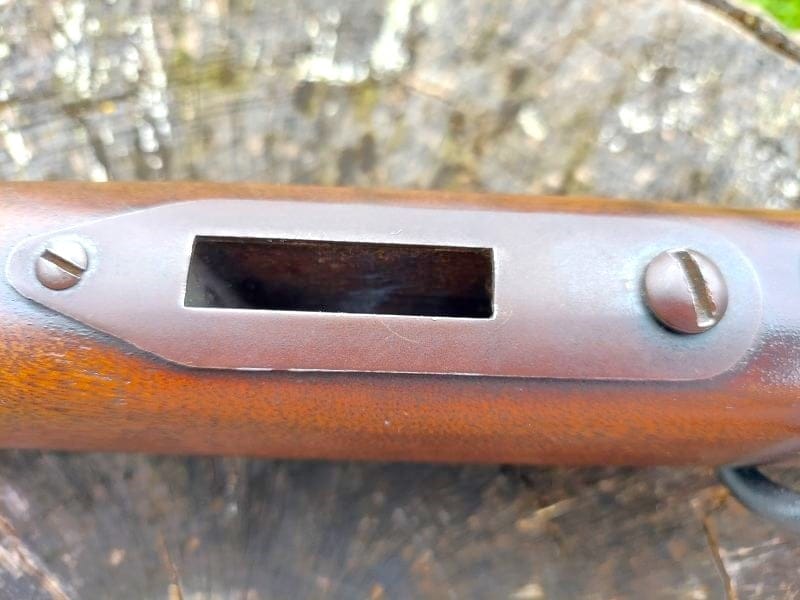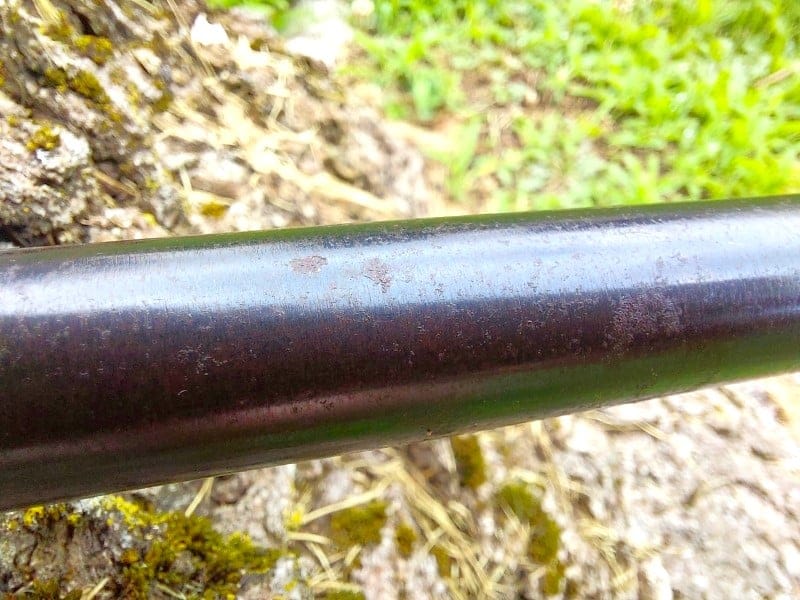Oxidation. Better known as rust.
What should we do if we notice one of our favorite shooting irons has developed some rust? I mean, aside from a high-pitched shriek of exasperation and dismay. Seeing one of our beloved guns marred by rust is enough to bring a tear to a glass eye!
Let’s take a look at some methods that might be of help to shooters.
Enemies Of Firearms
Perhaps you’ve heard of the tongue-in-cheek quip that firearms have only two enemies: rust and politicians. Despite the comical nature of the statement, there’s some truth in it.
Caution!
Although it seems like a no-brainer, I’ll say it. Make 100% certain your firearm is unloaded before cleaning or removing rust. Field stripping it is not a bad idea either because it makes the firearm easier to handle and further ensures there will be no negligent discharge. Most negligent discharges occur during cleaning or working on firearms.

What Is Rust?
Rust is a form of iron oxide that forms from a reaction between iron and oxygen when it comes into contact with water. Moisture in the air works as an accelerant for causing rust on metal surfaces.

An Ounce of Prevention
In the case of firearms, an ounce of prevention is worth a pound of cure. No one wants to take out their beloved rifle, pistol, or shotgun to find that it has begun developing the dreaded rust. Unfortunately, in the real world, it does happen. Perhaps we’ve had the gun out in the rain and didn’t have time to wipe it down with oil or clean it before we put it away. Or else we simply forgot to. Storing firearms in cases with cloth linings also seems to provide a perfect environment to promote rust.

Cleaning
Regular cleaning helps to get rid of corrosive materials that might settle inside your firearm. There are plenty of solvents on the market to choose from, and most will get the job done. Personally, I like spray solvents (some aerosol or in a spray bottle) because they really get into the nooks and crannies of firearms that are otherwise hard to reach. Some clean, while others clean and lubricate at the same time. I like solvents that simply clean, preferring to lubricate as a separate step after cleaning is complete.
How often should we clean firearms? Opinions vary. A good friend of mine, who works for Sig, cleans his pistols and other firearms every 5,000 to 6,000 rounds. At first, I thought that seemed extreme, but it’s working very well for him, and believe me, he shoots a lot and is extremely experienced and knowledgeable. You might not choose to clean that infrequently, but I think it goes to show that firearms are often more durable than many people give them credit for.
Lubrication
After cleaning, it’s time to lubricate. Lubricants keep water from affecting your firearm’s metal, both inside and out. There are tons of lubricants on the market today, so you have plenty of choices. Just don’t use WD-40 because it tends to gum things up in the long run. Also, over-lubing the inside is not a good idea because sometimes, less is more. Most modern pistols only require a few drops of lube at key points. Too much lube can gum up the works.
Many firearms these days sport protective finishes that work very effectively. With most of my pistols, I have zero concerns about rust developing on their slide or elsewhere. However, on firearms with standard blued finishes, rust is always a sinister specter, lurking around every corner, just waiting to move in and spoil everyone’s fun. I have a few firearms with blued finishes, and I often give them a wipe-down with gun oil to stave off rust. Even so, over the years when these guns were sitting without my attention, rust managed to move in and claim a foothold, much to my consternation.
If I’m storing a firearm long-term, I’ll go rather heavy on the wipe-down on the outside of the gun, reasoning that more is better and will last longer.
If I get one of my blued firearms out and touch the metal, I wipe it down with oil because the residue from touching the blued steel can lead to rust.
Storage
For my rifles, I don’t keep them stored in cases because I’ve had bad luck doing that. In fact, I don’t even store my pistols in cases long-term. Cases tend to trap moisture and don’t allow airflow, which promotes rust. If I’m transporting either, keeping them in a case for a short time doesn’t prove to be an issue.

What if rust sets in?
Despite our efforts, rust can still afflict our firearms. Or maybe we take possession of a gun that’s already rusted. Here are a few possible solutions to your rust issues.
Oil It!
Oil any spots or areas of rust and let the oil soak in for about half an hour. Then scrub the heck out of them. A toothbrush works well for scrubbing in the oil. Nylon or brass bristles are best; avoid wire or steel bristles.
Note: When applying oil, apply it directly to the rag if you’re using one, and then use the rag to apply it to the gun. That helps prevent the oil from getting into areas of the gun that you don’t want, such as into the stock, scope lens or other optics, lasers, leather sling, etc. It’s simply more controllable when on the rag.

Use a cotton rag to vigorously rub the surface rust. When that rag becomes dirty, switch to a clean rag and continue. Sometimes, the rag’s abrasion is enough to remove light surface rust by itself.
At first, it might feel rough as you hit resistance from the rust. As the rust is removed, you’ll feel less resistance, which is a good thing. Once the rust seems to be gone, and after the gun has rested a short time, apply oil to a fresh rag and give the gun a vigorous wipe down to make sure any rust that was missed is removed. Repeat until the rag is clean after rubbing.
If that doesn’t work…
Scrub It
After it soaks for a while, using very fine steel wool (#4 steel wool is the finest), gently rub the affected area. Be careful not to use something that’s too abrasive. In this case, less is more. This will sometimes be enough to remove the rust. Be advised that if you use the steel wool too aggressively, you’ll end up with a silver patch on your firearm where the bluing used to be.
A Penny And Oil
Apply a lubricant to the rust spots and let sit for about half an hour. Then use a penny to gently scrape the rust off of the surface. After that, wipe the area down with a clean cloth. An application of protective wax such as Renaissance Wax can help to keep the rust away.
Oil And Lead Pencil
This method works best for small spots of surface rust. Apply oil, wait a half hour, then gently use the pencil lead as a mild abrasive to scratch off the rust. The bluing should remain when the process is finished. As always, finish up by rubbing it down with some oil.
Consult A Professional
If all of these measures fail, it might be time to call in a professional gunsmith. They have methods that go beyond what a layperson is likely capable of.
If the firearm is particularly valuable or holds prominent sentimental value, it might pay you to consult a professional from the start. Meddling with the finish of a valuable firearm can easily destroy the value, which we undoubtedly don’t want to do.
In Closing
A soft, cautious approach is best when initially dealing with rust removal so that we don’t cause even more damage to the firearm’s finish. We might have to take the firearm to a professional if the rust goes below the surface. I’d especially go this route if the firearm holds significant financial or sentimental value.
Good luck in your battle against the forces of oxidation!


